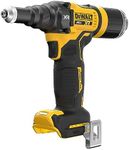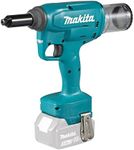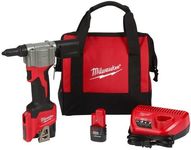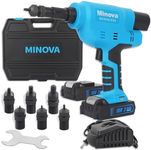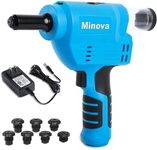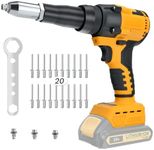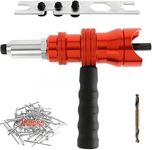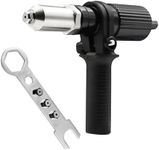Buying Guide for the Best Cordless Rivet Guns
Choosing a cordless rivet gun can make your fastening tasks much easier and more efficient, especially if you need portability and freedom from cords. The right tool will depend on the types of projects you plan to tackle, the materials you work with, and how often you’ll use the tool. Understanding the key specifications will help you find a rivet gun that matches your needs and ensures reliable performance.Battery Voltage and CapacityBattery voltage and capacity determine how powerful the rivet gun is and how long it can operate before needing a recharge. Higher voltage usually means more power, which is useful for tougher materials or larger rivets, while higher capacity (measured in amp-hours, Ah) means longer run time. For light, occasional work, a lower voltage and capacity may be sufficient, but for frequent or heavy-duty use, look for higher values to avoid interruptions.
Rivet Size CompatibilityThis spec tells you the range of rivet diameters the gun can handle. Some guns are designed for small, light-duty rivets, while others can handle larger, heavy-duty ones. If you mostly work with thin materials or small projects, a gun that supports smaller rivets is fine. For automotive, construction, or industrial tasks, make sure the tool can handle the larger sizes you’ll encounter.
Pulling ForcePulling force is the amount of force the tool can apply to set a rivet, usually measured in Newtons or pounds. Higher pulling force allows you to set larger or tougher rivets, especially in harder materials. If your projects involve thick or hard materials, choose a gun with a higher pulling force. For lighter tasks, a lower force is adequate and may make the tool lighter and easier to handle.
Stroke LengthStroke length is how far the tool’s mechanism moves to pull and set the rivet. A longer stroke can set longer rivets in one go, which is important for certain applications. If you use a variety of rivet lengths, look for a gun with a longer stroke. For standard, short rivets, a shorter stroke is usually sufficient.
Weight and ErgonomicsThe weight and design of the rivet gun affect how comfortable it is to use, especially for extended periods. Lighter tools are easier to handle and reduce fatigue, while ergonomic grips and balanced designs make the tool more comfortable. If you’ll be using the tool for long sessions or in awkward positions, prioritize comfort and weight.
Nosepiece OptionsNosepieces are the parts that hold the rivet in place, and different sizes are needed for different rivet diameters. Some guns come with multiple interchangeable nosepieces. If you plan to use a range of rivet sizes, make sure the tool includes or supports the nosepieces you need. For single-size use, this is less important.
Mandrel CollectionWhen a rivet is set, the leftover mandrel (the pin) is ejected from the tool. Some rivet guns have a built-in mandrel collection system to catch these pieces, keeping your workspace cleaner and safer. If you work in environments where cleanliness or safety is a concern, or if you want to avoid picking up mandrels by hand, look for this feature.
